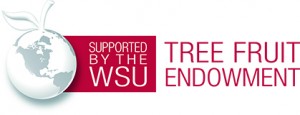Written by: Sarah Kostick, WSU Horticultural Doctoral Candidate. May 2019.
Most apple cultivars are susceptible to fire blight, but symptoms and severity of infections can vary by cultivar. In 2016 and 2017, we screened 94 apple cultivars and important breeding parents for fire blight resistance and susceptibility (see methods for details). Figure 1 demonstrates the variation in fire blight shoot lesions that can be observed among apple cultivars.
Fig. 1. Variation in fire blight susceptibility responses among cultivars (photo credits: S. Kostick)
Most of the apple cultivars we tested were susceptible to fire blight (Table 1). However, the degree of susceptibility depended on the cultivar (Table 1). Enterprise was the only cultivar that did not develop any fire blight symptoms in either year of the two-year study. Many cultivars (e.g. Granny Smith, Winter Banana) were consistently highly susceptible. Of interest, WA 38 had more moderate responses in both years (Table 1). Aurora Golden Gala, Empire, and Enterprise were consistently moderately to highly resistant (Table 1). Cultivar responses were relatively consistent between years. For example, a cultivar that had a highly susceptible response in 2016 often had a highly susceptible response in 2017. However, some cultivars (e.g. Honeycrisp, Pinova, Spartan) appeared highly or moderately susceptible in one year and moderately resistant in the other. For a given cultivar, differences in fire blight responses between years could potentially be attributed to: (1) variable environmental conditions; (2) differences in tree age and/or vigor between years; and (3) inoculation of shoots that were terminating growth in one of the years. Variation in cultivar response to fire blight between years demonstrates the importance of evaluating susceptibility in multiple field seasons.
Conclusions
- Most cultivars had a susceptible response to fire blight in 2016 and/or 2017.
- Cultivar responses were relatively consistent between years.
- Although most cultivars are susceptible, fire blight symptoms can vary among cultivars.
- Several cultivars including Aurora Golden Gala, Empire, and Enterprise had moderately to highly resistant responses in both years.
Methods

We determined fire blight resistance/susceptibility levels of 94 apple cultivars and important breeding parents through a two-year, replicated field inoculation study that focused on shoot infection. Cultivars on M.111 rootstocks were planted at WSU Columbia View Research Orchard. In 2016 and 2017, we inoculated multiple actively-growing shoots per tree with a virulent strain of Erwinia amylovora (Figs. 2 & 3). We used the average proportion of current season’s shoot growth that was blighted to quantify a cultivar’s response to fire blight; higher average values indicate higher susceptibility. We classified cultivars as highly susceptible, moderately susceptible, intermediate, moderately resistant, or highly resistant by comparing cultivar responses with the responses of four controls Jonathan (highly susceptible), McIntosh (moderately susceptible), Delicious (moderately resistant), and Russian seedling (highly resistant). Fire blight is a variable disease; thus, resistance/susceptibility classifications should always be viewed relative to controls’ responses within a given year.

Table 1. Select cultivar responses to fire blight in 2016 and 2017 quantified as the average proportion of shoot length that was blighted (SLB). Higher values indicate a more susceptible response to fire blight. In 2016 and 2017, we classified cultivars’ responses as highly susceptible (HS), moderately susceptible (MS), intermediate (I), moderately resistant (MR), or highly resistant (HR). Generally increasing susceptibility from top of table to bottom (sorted by resistance/susceptibility classification). Data from Kostick et al. (2019).
Full study details
Kostick, S.A., Norelli, J.L., & Evans, K.M. 2019. Novel metrics to classify fire blight resistance of 94 apple cultivars. Plant Pathology 68, 985-996. https://doi.org/10.1111/ppa.13012
Additional references
- Lee, S.A., Ngugi, H.K., & Halbrendt, N.O. et al. 2010. Virulence characteristics accounting for fire blight disease severity in apple trees and seedlings. Phytopathology 100, 539-550.
- Norelli, J.L., Jones, A.L., & Aldwinckle, H.S. 2003. Fire blight management in the twenty-first century using new technologies that enhance host resistance in apple. Plant Disease 87, 756-765.
- van der Zwet, T., Orolaza-Halbrendt, N., & Zeller, W. 2012. Fire blight, History, Biology and Management. St Paul, MN, USA: APS Press.





